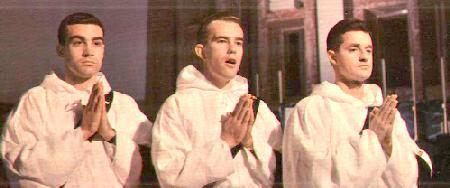Sung in English with a Spoken Narration
by Friars of the A Capella Choir of St. Rose Priory

Valerian Thomas, O.P., Boniface Perry, O.P., Isidore Metzger, O.P.
passion.rm (RealMedia)
It was only natural that the powerful story of Our Lord's Passion and death should be set to music, and the practice is centuries old. Not only the Passion narrative but also the portions of the Psalms, Old Testament Prophecies, and Lamentations, which pertain to the Passion narrative, were set to the chants sung in Holy Week. Chant was the first musical medium of expression used for the Passion narrative; then the Renaissance composers used polyphony for the Holy Week lamentations and responses, followed by the grandeur of Bach's St. Matthew and St. John Passions; composers of our own time, such as Stravinsky and Polenc, have also set the inspired word to music.
In this recording chant has been chosen as the medium to tell the story of Christ's passion, death, and resurrection. Chant was the first-used and simplest means of presenting the Passion narrative musically. The presentation in this recording depends on the unaccompanied solo voice to convey (with simplicity) the stark reality, the pathos, grandeur, and triumph of the end of Our Lord's earthly life.
The Passion narratives of Matthew, Mark, Luke, and John formerly were read on Palm Sunday, Monday and Tuesday in Holy Week, and on Good Friday. The practice developed in the Middle Ages of singing the Passion narrative, with three voices of different range and speed taking different and speciflc parts. A low voice singing slowly took the part of Christ. A medium-high voice singing faster than the voice of Christ took the part of the narrator who tells the story. A high-pitched voice singing rapidly took the parts of Judas, the High Priests, Pilate, and the Jews. By using these three voices, dramatic emphasis was added to the already powerful narrative. The speaking narrator has been introduced in this recording to add variety to the narrative presentation and to mark transitions within the narrative. The dramatic singing of the Passion narrative climaxes in two passages, the first on "Take him, crucify him," and the second on "My God, why have you forsaken me?"
The English adaptation in this recording has been taken from all four Gospel accounts to present a more unified, concise, and complete dramatic picture. The English singing of the Passion narrative follows the Latin chant closely, although exceptions have been made for the rhythmic differences of the English language and the dramatic purposes of the recording. This recording is not a liturgical offering; it is the story of Our Lord's Passion and death presented as a story with the traditional Gospel chant of Holy Week used as the medium of expression.
The performers on this record were friars of the Dominican Order, known offlcially as the Order of Preachers. The term "friar," originally derived from the Latin frater, or brother, came in time to be applied to members of those religious orders who combined apostolic work and the care of souls with monastic lite. The friar differed from the monk in that he was able to move from place to place as his labors required, and was not bound to one house or abbey. In this presentation the friars of St. Rose Priory continue the seven century-old Dominican tradition of preaching and teaching the truth of Christ, hoping by this recording to make the beauty and power of the Gospel narrative better appreciated and more meaningful.
Musical Director: Malachy Quinn, O.P.
Production Coordinator: Jude Johnson, O.P.
Speaking narrator: Cyril Dwiggins, O.P.
Singing narrator: Boniface Perry, O.P.
Christ: Valerian Thomas, O.P.
The crowd: Isidore Metzger, O.P.All rights reserved. © Copyright 1960 Dominican Fathers.
| Index | Home | O P Sites | Search | |